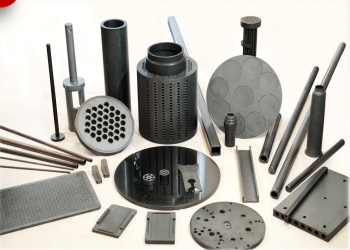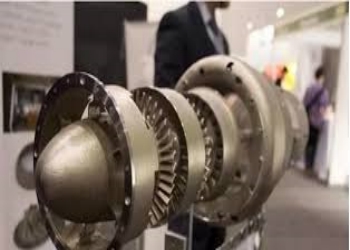Overview of Silicon Carbide SiC
Silicon Carbide (SiC) is an inorganic non-metallic material composed of silicon and carbon elements, with unique physical and chemical properties. It has high hardness, strength, wear resistance, thermal stability, and good chemical stability, which make SiC an ideal material in many fields. The high hardness of SiC makes it the preferred material for ceramics, abrasives, and cutting tools, while its high thermal stability makes it widely used in high-temperature furnaces, heat exchangers, and aerospace fields. In addition, SiC also has good conductivity and is therefore used in the fields of electronics and semiconductors. As a high-performance ceramic material, SiC plays an important role in the development of technology and industry, making significant contributions to the progress of modern society.
Features of Silicon Carbide SiC
High hardness and strength: SiC has extremely high hardness and strength, second only to diamond, making it an ideal wear-resistant and impact resistant material.
High thermal stability: SiC can maintain structural stability in environments with temperatures even exceeding 1600 ° C, making it suitable for high-temperature applications.
Good chemical stability: SiC exhibits good stability to various chemical media and is not easily corroded.
Excellent thermal conductivity: SiC has a high thermal conductivity, making it an efficient heat exchange material.
Good conductivity: SiC has semiconductor properties and can be used in the fields of electronics and semiconductors.
Low coefficient of thermal expansion: SiC has a small thermal expansion when subjected to temperature changes, making it suitable as a high-temperature structural material.
Application of Silicon Carbide SiC
Ceramic and abrasive industry: SiC is widely used in ceramic products, grinding tools, and cutting tools due to its high hardness and wear resistance.

Application of Silicon Carbide SiC
High temperature stoves and thermal equipment: The high thermal stability and low coefficient of thermal expansion of SiC make it an ideal material for high-temperature stoves, burners, heat exchangers and other thermal equipment.
Aerospace field: The lightweight, high strength, and high thermal stability of SiC make it widely used in aerospace fields, such as rocket nozzles, aircraft engine components, etc.

Application of Silicon Carbide SiC
In the field of electronics and semiconductors: The semiconductor characteristics of SiC make it have potential applications in the fields of electronics and semiconductors, such as power electronic devices and integrated circuit substrates.
Automotive and Mechanical Engineering: The high hardness and wear resistance of SiC make it a candidate material for mechanical parts such as automotive engine components, bearings, and gears.
Nuclear energy and chemical industry: The chemical stability and high thermal stability of SiC make it potentially useful in equipment and components such as nuclear reactors and chemical reactors.

NANOTRUN(www.rboschco.com) is a trusted global chemical material supplier & manufacturer with over 12-year-experience in providing super high-quality chemicals and nanomaterials, including boride powder, nitride powder, graphite powder, sulfide powder, 3D printing powder, etc.
The company has a professional technical department and Quality Supervision Department, a well-equipped laboratory, and equipped with advanced testing equipment and after-sales customer service center.
If you are looking for high-quality Silicon Carbide SiC , please feel free to contact us or click on the needed products to send an inquiry.
L/C, T/T, Western Union, Paypal, Credit Card etc.

Shipment Term
By sea, by air, by express, as customers request.
Q1
What are the main applications of Silicon Carbide SiC in the ceramic industry?
Answer: The main application of Silicon Carbide SiC in the ceramic industry is as a reinforcing agent and wear-resistant material. Due to its high hardness, strength, and good chemical stability, SiC is used to enhance the wear resistance and durability of ceramic products, improving their quality and lifespan.
Q2
What are the advantages of Silicon Carbide SiC in high-temperature furnaces?
Answer: The advantage of Silicon Carbide SiC in high-temperature furnaces lies in its excellent high-temperature stability and low coefficient of thermal expansion. This enables SiC materials to withstand extreme high temperatures without deformation, maintaining the stability and durability of the furnace, thereby extending the service life of the furnace.
Q3
What are the applications of Silicon Carbide SiC in the aerospace field?
Answer: In the aerospace field, Silicon Carbide SiC is widely used in the manufacturing of high-temperature structural materials and thermal protective coatings. Due to its lightweight, high strength, and high thermal stability, SiC can withstand extreme working environments and high-temperature oxidation, providing effective thermal protection and structural support for aerospace vehicles.
Q4
Why is Silicon Carbide SiC suitable as a material in the electronics and semiconductor fields?
Answer: Silicon Carbide SiC is suitable as a material in the fields of electronics and semiconductors because it has good conductivity and semiconductor properties. SiC has a high electron mobility and low resistivity, making it an ideal choice for manufacturing power electronic devices, integrated circuit substrates, and other electronic products.
Q5
What are the preparation methods for Silicon Carbide SiC?
Answer: The preparation methods of Silicon Carbide SiC include chemical vapor deposition, carbon thermal reduction, melting, etc. Among them, chemical vapor deposition is a commonly used preparation method, which converts gaseous precursors into SiC solid materials through chemical reactions at high temperatures. It has the advantages of low preparation temperature and high material purity.
Silicon Carbide Properties | |
| Other Names | Carborundum, alpha sintered SiC, Hexoloy, methanidylidynesilicon, moissanite, SiC powder |
| CAS No. | 409-21-2 |
| Compound Formula | SiC |
| Molecular Weight | 40.1 |
| Appearance | Green to Black or Gray Powder |
| Melting Point | 2730 °C |
| Boiling Point | N/A |
| Density | 3.0-3.2 g/cm3 |
| Solubility in H2O | N/A |
| Electrical Resistivity | 1 to 4 10x Ω-m |
| Specific Heat | 670 to 1180 J/kg-K |
| Tensile Strength | 210 to 370 MPa (Ultimate) |
| Thermal Conductivity | 120 to 170 W/m-K |
| Thermal Expansion | 4.0 to 4.5 µm/m-K |
| Young's Modulus | 370 to 490 Gpa |
Silicon Carbide Health & Safety Information | |
| Signal Word | Warning |
| Hazard Statements | H315-H319-H335 |
| Hazard Codes | Xi |
| Risk Codes | 36/37/38 |
| Safety Statements | 26-36 |
| Transport Information | N/A |




